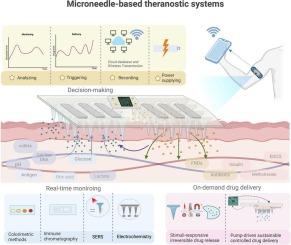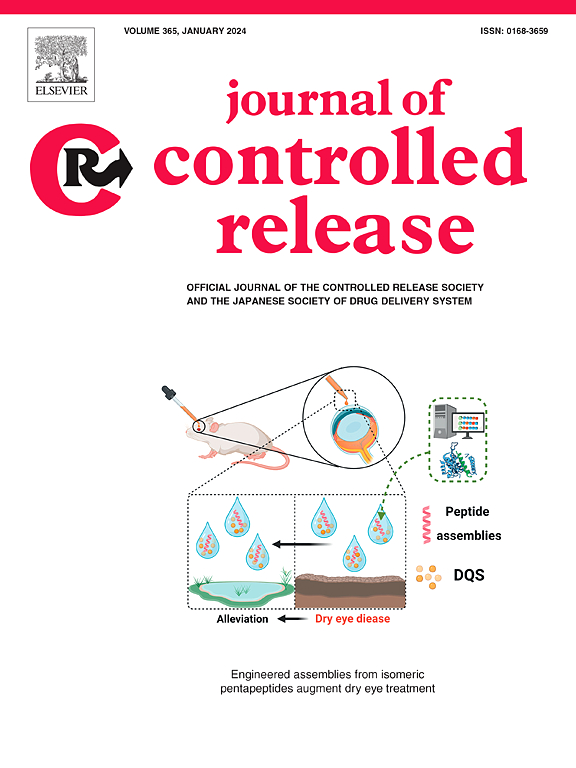Toward precision medicine: End-to-end design and construction of integrated microneedle-based theranostic systems
IF 10.5
1区 医学
Q1 CHEMISTRY, MULTIDISCIPLINARY
引用次数: 0
Abstract
With the growing demand for precision medicine and advancements in microneedle technology, microneedle-based drug delivery systems have evolved into integrated theranostic platforms. However, the development of these systems is currently limited by the absence of clear conclusions and standardized construction strategies. The end-to-end concept offers an innovative approach to theranostic systems by creating a seamless process that integrates target sampling, sensing, analysis, and on-demand drug delivery. This approach optimizes each step based on data from the others, effectively eliminating the traditional separation between drug delivery and disease monitoring. Furthermore, by incorporating artificial intelligence and machine learning, these systems can enhance reliability and efficiency in disease management, paving the way for more personalized and effective healthcare solutions. Based on the concept of end-to-end and recent advancements in theranostic systems, nanomaterials, electronic components, micro-composites, and data science, we propose a modular strategy for constructing integrated microneedle-based theranostic systems by detailing the methods and functions of each critical component, including monitoring, decision-making, and on-demand drug delivery units, though the total number of units might vary depending on the specific application. Notably, decision-making units are emerging trends for fully automatic and seamless systems and featured for integrated microneedle-based theranostic systems, which serve as a bridge of real-time monitoring, on-demand drug delivery, advanced electronic engineering, and data science for personalized disease management and remote medical application. Additionally, we discuss the challenges and prospects of integrated microneedle-based theranostic systems for precision medicine and clinical application.

迈向精准医疗:基于微针的集成治疗系统的端到端设计与构建。
随着精准医疗需求的不断增长和微针技术的进步,基于微针的给药系统已发展成为综合治疗平台。然而,由于缺乏明确的结论和标准化的构建策略,目前这些系统的发展受到了限制。端到端概念为治疗系统提供了一种创新方法,它创建了一个集目标取样、传感、分析和按需给药于一体的无缝流程。这种方法根据其他步骤的数据优化每个步骤,有效消除了传统的药物输送和疾病监测之间的分离。此外,通过结合人工智能和机器学习,这些系统还能提高疾病管理的可靠性和效率,为更个性化、更有效的医疗解决方案铺平道路。基于端到端概念以及治疗系统、纳米材料、电子元件、微复合材料和数据科学的最新进展,我们提出了构建基于微针的集成治疗系统的模块化策略,详细说明了每个关键组件的方法和功能,包括监测、决策和按需给药单元,但单元总数可能因具体应用而异。值得注意的是,决策单元是全自动无缝系统的新兴趋势,也是基于微针的集成治疗系统的特色,它是实时监测、按需给药、先进电子工程和数据科学的桥梁,可用于个性化疾病管理和远程医疗应用。此外,我们还讨论了基于微针的集成治疗系统在精准医疗和临床应用中面临的挑战和前景。
本文章由计算机程序翻译,如有差异,请以英文原文为准。
求助全文
约1分钟内获得全文
求助全文
来源期刊

Journal of Controlled Release
医学-化学综合
CiteScore
18.50
自引率
5.60%
发文量
700
审稿时长
39 days
期刊介绍:
The Journal of Controlled Release (JCR) proudly serves as the Official Journal of the Controlled Release Society and the Japan Society of Drug Delivery System.
Dedicated to the broad field of delivery science and technology, JCR publishes high-quality research articles covering drug delivery systems and all facets of formulations. This includes the physicochemical and biological properties of drugs, design and characterization of dosage forms, release mechanisms, in vivo testing, and formulation research and development across pharmaceutical, diagnostic, agricultural, environmental, cosmetic, and food industries.
Priority is given to manuscripts that contribute to the fundamental understanding of principles or demonstrate the advantages of novel technologies in terms of safety and efficacy over current clinical standards. JCR strives to be a leading platform for advancements in delivery science and technology.
 求助内容:
求助内容: 应助结果提醒方式:
应助结果提醒方式:


